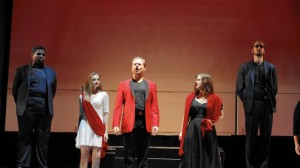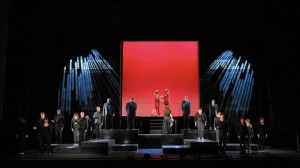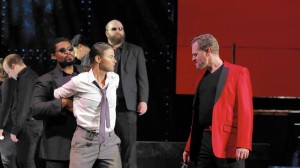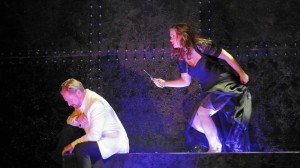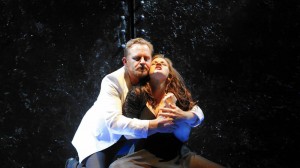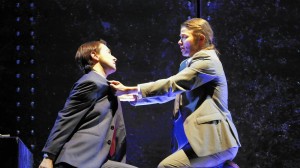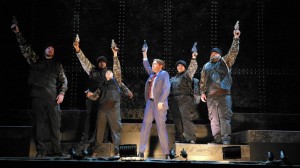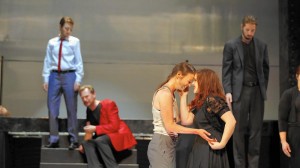LUCIO SILLA REVELS IN YOUTH’S BEAUTY
Mozart’s early chamber opera Lucio Silla, written at the precocious age of sixteen, is an excellent example of the bel canto style. Not only is the singing, quite literally, “beautiful,” but there is a steady progression of recitative, solo arias, duets, etc. that showcase the extraordinary capabilities of the human voice. Astonishingly numerous are the voca fireworks: piercing high notes, acrobatic coloratura, virtuosic cadenzas, and oodles of delicious trills. It’s the kind of music that you almost wish you could stop and savor at times, but instead it drives onward for two and half hours with a single intermission.
In reviving this somewhat obscure opera seria, Chicago Opera Theater (COT) retains Mozart’s original music while taking some liberties with Giovanni de Gammera’s libretto. The plot is quite simple. Lucio Silla (or Lucius Sulla), is a Roman dictator bent on marrying Giunia, the daughter of his defeated rival. Giunia, however, is betrothed—in this production, married—to Cecilio. In order to enlist the support of Cecilio’s friend Cinna, Silla offers him his sister Celia in marriage. Naturally, Giunia refuses Silla. Cecilio takes up arms on her behalf and is arrested. Silla unexpectedly has a change of heart, releases the two lovers, and resigns the dictatorship.
[SPOILER ALERT: COT’s great innovation is accounting for Silla’s change of heart by showing him kill his sister Celia in a moment of rage. With Celia out of the picture, the third and final act comes to a swifter and more dramatic end.]
One other COT modification that works surprisingly well is the translation of all recitative into English, while retaining the arias and choruses in Italian. The transition from English to Italian can seem abrupt on occasion, but does increase intelligibility. COT reduces the opera’s six roles to just five, cutting out the part of Aufidio, friend of Silla. This leaves four parts for soprano and one for tenor (instead of two), resulting in a higher register overall. One of the four soprano roles, moreover, was originally performed by a male castrato. In the current production, two of the three male roles are occupied by women.
Although Ryan MacPherson’s Lucio Silla dominates the opera with his dictatorial ways and lone male voice, it is Maeve Höglund’s Giunia that provides the emotional center. Mozart cunningly shifts the music into the minor key when she sings. Her breadth of expression and sumptuous fluidity stunningly convey her character’s joys and sorrows, loyalty and fidelity. If Christine Arand as Cecilio and Ava Pine as Cinna both look and act the part of men remarkably well, their voices are anything but masculine. Pine’s delightfully clear tone seems deceptively effortless, while Arand’s blends seamlessly with Höglund in the hopeful duet that crowns the first act. As Celia, the vampish Valerie Vinzant makes the most of a minor role. Her pretty voice sings sweetly and delicately, contrasting superbly with her tyrannical stage brother Silla.
Artistic Director Andreas Mitisek’s contemporary and always creative staging enhances rather than distracts from this twice-removed period piece. A simple set, primary colors (black, white, red), and Andrew Meyer’s effective lighting design, allow Mozart’s music to shine in all its youthful splendor. A challenge that Mitisek rises to with aplomb is how to stage this small-scale chamber opera in the vast space of the Harris Theater. He does this partly by augmenting the spare cast with members of the Apollo Chorus, who act as Silla’s guards, and even the ghostly father of Giunia, in addition to portraying the populace of Rome. And the pantomime performed during the overture introduces the plot with economy and style.
Chicago Opera Theatre’s Lucio Silla proves that Lyric Opera by no means has a monopoly on Mozart (see Stage & Cinema‘s review of The Marriage of Figaro). It also proves that COT can produce older repertoire just as well as world premieres. What makes Lucio Silla absolutely worthwhile, however, is the outstanding bel canto singing of this incredibly talented cast. It’s the rare production that entices you back for a second or third experience of sheer ecstasy. Bellissima!
photos by Liz Lauren
Lucio Silla
Chicago Opera Theater
Harris Theater, 205 E. Randolph
ends on October 4, 2015
for tickets, call 312.704.8414 or visit ChicagoOperaTheater.org
for info on more Chicago Theater, visit TheatreinChicago.com

